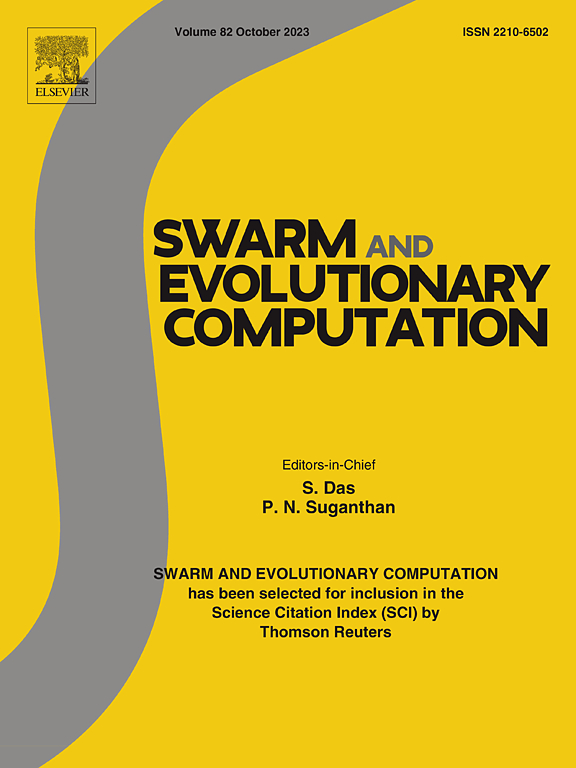A decompose-and-learn multi-objective algorithm for scheduling large-scale earth observation satellites
IF 8.2
1区 计算机科学
Q1 COMPUTER SCIENCE, ARTIFICIAL INTELLIGENCE
引用次数: 0
Abstract
In recent studies, task scheduling problems of earth observation satellites (EOSs) still encounter large difficulties when they meet the increasing number of satellites. Moreover, multiple objectives and increasing number of tasks must be considered in business affairs. To effectively address these issues, considering satellite orbits as independent resources, a multi-objective algorithm is tailored for earth observation satellites scheduling problems (EOSSPs) in this paper. The algorithm includes a novel dynamic learning task allocation mechanism and a bidirectional sorting strategy with global patching method. Specifically, the mechanism works as an evolution operator to allocate tasks to appropriate orbits thus reducing problem complexity and the strategy is tailored to schedule observation windows to corresponding tasks. With the mechanism, original EOSSP can be decomposed into subproblems through the task allocation mechanism, with each task assigned to an corresponding orbit using adaptively updating guideline values. The decision space of a subproblem is limited within one single orbit, which will vastly decrease the complexity of the original large-scale EOSSP. Then, the bidirectional sorting strategy will schedule specific observation windows of each orbit to the candidate tasks. Since the algorithm is proposed to solve large-scale EOSSPs with multi-orbit and multi-objective, it is referred here as LS2MO-SS. Finally, extensive experiments are conducted on ten large-scale problems with different tasks to evaluate the performance of the multi-objective algorithm, the proposed evolution operator, and the bidirectional sorting strategy. The comparative results indeed validate the effectiveness of the proposed algorithms.
大型对地观测卫星调度的分解学习多目标算法
在近年来的研究中,对地观测卫星的任务调度问题在卫星数量不断增加的情况下仍然遇到较大的困难。此外,在商业事务中必须考虑多个目标和越来越多的任务。为了有效地解决这些问题,本文将卫星轨道作为独立的资源,针对对地观测卫星调度问题,提出了一种多目标算法。该算法包括一种新的动态学习任务分配机制和一种具有全局修补方法的双向排序策略。具体来说,该机制作为演化算子将任务分配到合适的轨道上,从而降低了问题的复杂性,并为相应的任务安排观测窗口。该机制通过任务分配机制将原始EOSSP分解为子问题,并利用自适应更新的指导值将每个任务分配到相应的轨道上。子问题的决策空间被限制在一个轨道内,这将大大降低原大规模EOSSP的复杂度。然后,双向排序策略将每个轨道的特定观测窗口安排到候选任务上。由于该算法是针对多轨道、多目标的大规模eossp问题提出的,本文将其简称为LS2MO-SS。最后,在10个具有不同任务的大规模问题上进行了大量实验,以评估多目标算法、提出的进化算子和双向排序策略的性能。对比结果确实验证了所提算法的有效性。
本文章由计算机程序翻译,如有差异,请以英文原文为准。
求助全文
约1分钟内获得全文
求助全文
来源期刊

Swarm and Evolutionary Computation
COMPUTER SCIENCE, ARTIFICIAL INTELLIGENCEC-COMPUTER SCIENCE, THEORY & METHODS
CiteScore
16.00
自引率
12.00%
发文量
169
期刊介绍:
Swarm and Evolutionary Computation is a pioneering peer-reviewed journal focused on the latest research and advancements in nature-inspired intelligent computation using swarm and evolutionary algorithms. It covers theoretical, experimental, and practical aspects of these paradigms and their hybrids, promoting interdisciplinary research. The journal prioritizes the publication of high-quality, original articles that push the boundaries of evolutionary computation and swarm intelligence. Additionally, it welcomes survey papers on current topics and novel applications. Topics of interest include but are not limited to: Genetic Algorithms, and Genetic Programming, Evolution Strategies, and Evolutionary Programming, Differential Evolution, Artificial Immune Systems, Particle Swarms, Ant Colony, Bacterial Foraging, Artificial Bees, Fireflies Algorithm, Harmony Search, Artificial Life, Digital Organisms, Estimation of Distribution Algorithms, Stochastic Diffusion Search, Quantum Computing, Nano Computing, Membrane Computing, Human-centric Computing, Hybridization of Algorithms, Memetic Computing, Autonomic Computing, Self-organizing systems, Combinatorial, Discrete, Binary, Constrained, Multi-objective, Multi-modal, Dynamic, and Large-scale Optimization.
 求助内容:
求助内容: 应助结果提醒方式:
应助结果提醒方式:


